We’ve all heard the saying before: You should drink 8 glasses of water a day. Some doctors even recommend more than that depending on your lifestyle, body size, and general health. In fact, The Institute of Medicine recommends women drink 9 cups (2.2 liters) of water daily. For men, they recommend drinking 13 cups (3 liters) a day. Now let me ask you a very simple question: Do you ever actually drink that much water? Don’t lie. A lot of people struggle with this (myself included).
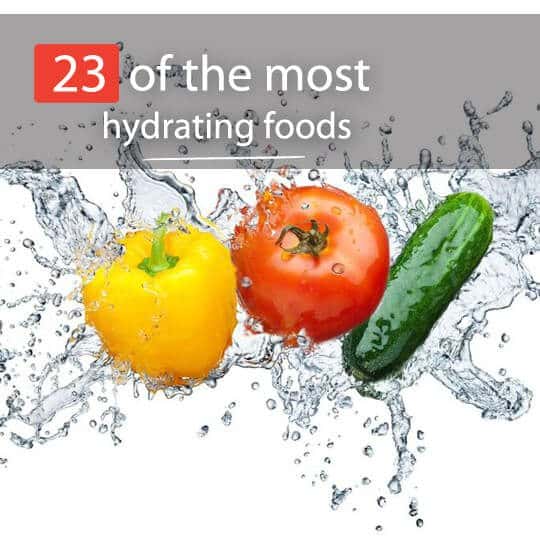
I have a juicy secret to tell you, though. Staying hydrated isn’t as hard as it sounds. According to the Institute of Medicine, about 80 percent of the water you consume comes from beverages, while the remaining 20 percent actually comes from food. That’s right … along with drinking water, you can also boost your H2O consumption from the foods you eat. A lot of fresh fruits and vegetables have an extremely high water content, which helps keep the body hydrated. There’s actually an added bonus to consuming hydrating foods since many are also rich in antioxidants, vitamins, electrolytes, and fiber that are great for health.
1) Cucumber
Water Content: 96%
This popular summer vegetable has the highest water content of any solid food, meaning it can help keep you hydrated when you’re doing outdoor activities under the strong sunshine. After taking a look at a cucumber’s nutritional value, though, you’ll definitely want to add them to your diet year-round. Cucumbers are loaded with vitamin C, K, and B. They also contain minerals such as copper, potassium, and manganese. For this reason, cucumbers can also help you to avoid nutrient deficiencies.
Since cucumbers are on the Dirty Dozen list (which means they have a high pesticide content and are ranked one of the most contaminated foods), it’s always a good idea to buy organic cucumbers. If you go organic, you still may be inclined to peel off the skin to get rid of the wax coating. Whether you buy organic or conventional, cucumbers are usually waxed to help them withstand the long journey from the farm to the supermarket. While all waxes are supposed to be food-grade, some are better than others. For example, natural waxes are preferred over petroleum-based wax coatings. Organic produce will not contain petroleum-based wax coatings. When going organic, you may want to simply clean the wax since a cucumber’s skin is one of the most nutrient-dense parts.

Cucumbers are extremely easy to eat. All you have to do is cut them up and you’re ready to go. You can either throw some slices in a salad, make cold cucumber soup, or you can simply munch on it!
2) Zucchini
Water Content: 95%
While the zucchini looks very similar to the cucumber, they are completely different vegetables. The one thing they do have in common, though, is their high water content and nutritional value. Zucchinis are rich in Vitamins C, B and A. They also contain key minerals such as calcium, iron, and magnesium. Of course, we can’t forget that zucchinis are 95 percent water, making them the perfect hydrating food. There’s a catch, though. Most of us eat zucchini cooked. When we roast or sauté zucchini, it loses a lot of its water content.
To reap the hydrating benefits, shred some raw zucchini into a salad. If you have a spiralizer this is the perfect time to whip that baby out and start making zucchini noodles. Speaking of zucchini noodles, some people even use raw zucchini as the “pasta” in pasta salads. You can also thinly slice your zucchini to make ribbons and add them to your salad.
3) Tomato
Water Content: 94%
According to the Department of Food Sciences at North Carolina State University, “Tomatoes are the second most produced and consumed vegetable nationwide and are a rich source of lycopene, beta-carotene, folate, potassium, vitamin C, flavonoids, and vitamin E.” Along with fighting cancer and improving our heart health, they’re 94 percent water. That means, among their many benefits, tomatoes also help keep us hydrated. If you’ve ever cut into a large tomato, you know how juicy they are. Seriously, liquid fills the etches in the cutting board! Of course, we can’t forget about the little cherry tomatoes. You can just pop those in between your teeth, bite down, and let the delicious juice fill your mouth.
Note: Since cherry tomatoes are another food on the Dirty Dozen list, it’s best to buy organic.
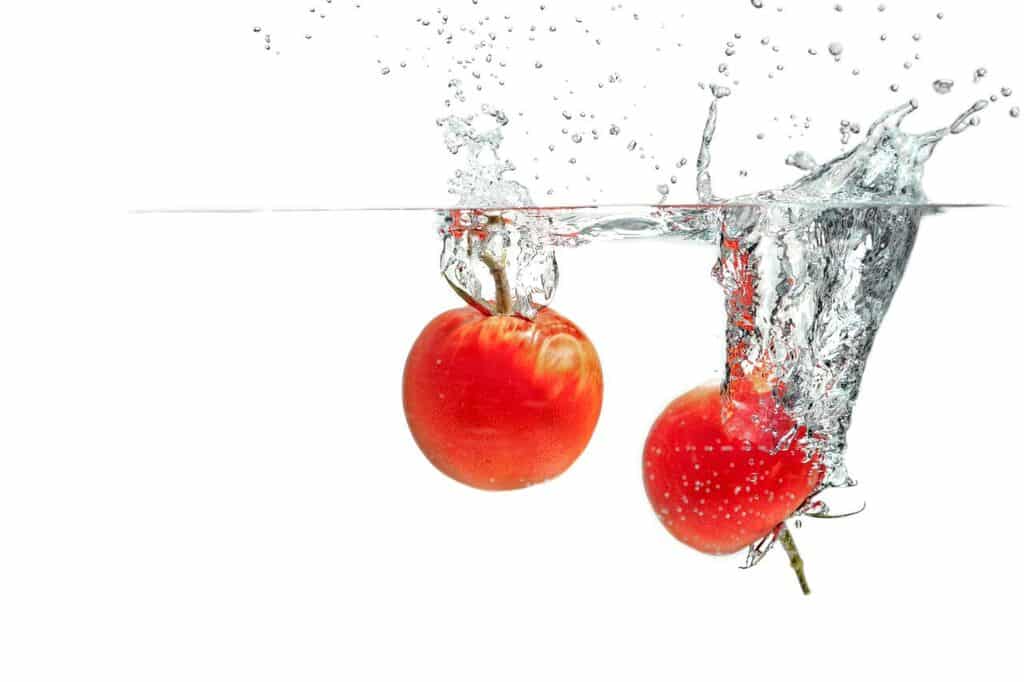
Tomatoes are a staple in salads. If you’re looking for a healthy on-the-go snack, just put a handful of cherry tomatoes into a Ziploc bag and head out the door.
4) Pineapple
Water Content: 87%
Pineapple is truly mother nature’s candy. Not only is it extremely hydrating, it’s also nutrient dense. Along with antioxidants, vitamins, and minerals, this delicious fruit is rich in the enzyme Bromelain. Bromelain is known to help fight cancer cells and prevent new cancer cells from forming.
Note: Pineapples are on the Clean Fifteen list, meaning they’re one of the least pesticide-laden crops. That’s mainly because pineapples have a thick layer of skin that protects the part you eat from being sprayed with harmful chemicals. GMOs aside, the crops listed on the Clean Fifteen are considered safe to buy conventional.
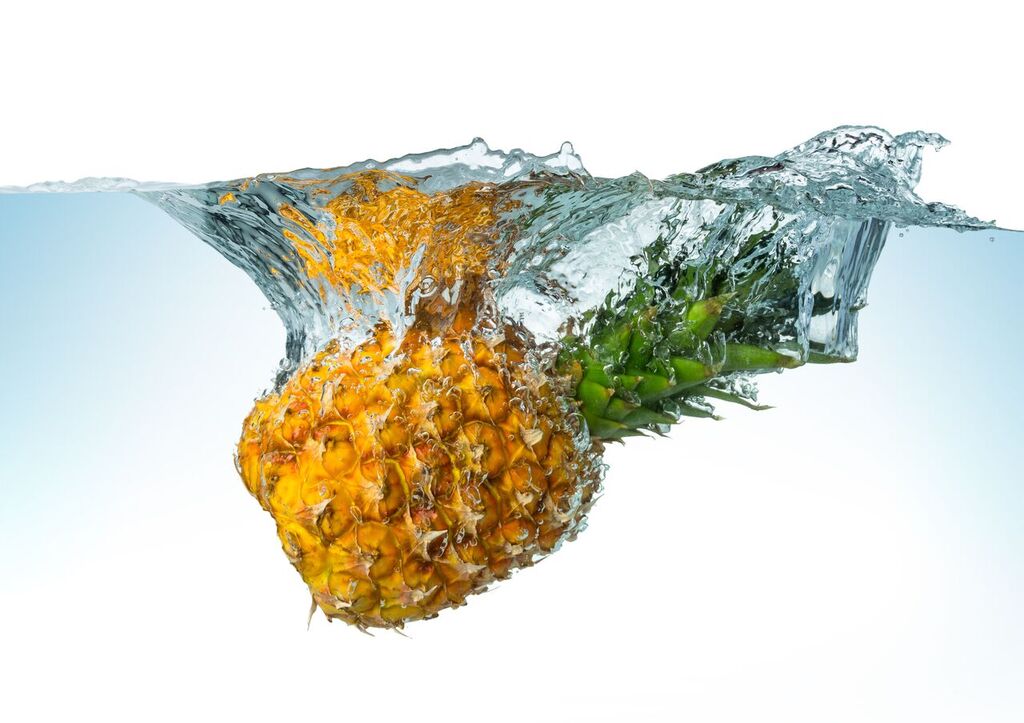
Pineapples are another great grab-and-go fruit. Just cut it up into chunks, throw it into a container, and go. Just make sure you don’t toss out the juice! If you’re eating a sit-down meal, you may also enjoy some pineapple chunks in your salad. Speaking of salad, this is the perfect fruit to sweeten up a fruit salad. Plus, don’t forget about smoothies!
5) Watermelon
Water Content: 92%
Remember back to when you were a little kid during the hot summer months. Did you run barefoot by the pool with watermelon juice dripping down your arm? Back then you were probably only concerned with the delicious and refreshing taste. Today, you may be happy to know that your summer fruit snack helped keep your body hydrated. In fact, a 2009 study from the University of Aberdeen Medical School found that the combination of salts, minerals, and natural sugars in certain fruits and vegetables can actually hydrate people more effectively than water or sports drinks. In that study, watermelon came out on top for being one of the best hydrating foods.

Watermelon is great in slices or in chunks. This is another great fruit that pairs well with salads. Just throw some chunks on a bed of lettuce, drizzle a little balsamic vinegar over it, and you’ve created a delicious lunch! Also, have you tried watermelon juice? Simply put some watermelon in a juicer and drink (yummmmyyyy)!
6) Celery
Water Content: 95%
If you’re on Pinterest, you may have seen one of those popular articles come across your newsfeed saying that celery is a “negative calorie” food. While that isn’t the case (it has 6 calories per stalk), all of the rumors about its high water content are true! Celery is 95% water. It’s because of that high water content that munching on celery is known as a natural headache remedy. Did you know headaches are often a result of dehydration? For quick headache relief, try juicing celery. If you’re someone who craves a crunch, though, celery is also great dunked in a little salad dressing.
Celery’s benefits don’t end at the high water content. The crunchy veggie also packs a nutritional punch. It contains vitamins A, C, K, and folate.
Note: Since celery is another food that’s on the Dirty Dozen list (which means they have a high pesticide content and are ranked one of the most contaminated foods), it’s always best to buy organic.
7) Strawberries
Water Content: 92%
All berries are extremely healthy. Strawberries, blueberries, raspberries, and blackberries — they’re all rich in antioxidants, vitamins, and minerals that boost the immune system and fight disease. When it comes to hydrating the body, though, strawberries are definitely your best bet. Juicy red strawberries are approximately 92 percent water as compared to raspberries, blackberries, and blueberries which are in the 80th percentile.
Note: Since strawberries are on the Dirty Dozen list, go organic whenever possible.
8) Iceberg Lettuce
Water Content: 96%
Over the years, iceberg lettuce has gotten a bad reputation by nutritionists for a lack of nutritional value. Many recommended trading in iceberg lettuce for darker greens, like spinach, kale, or romaine lettuce. Darker greens have higher amounts of fiber, key minerals, and vitamins. However, there is one category that iceberg lettuce wins — water content. Crispy iceberg has the highest water content of any lettuce, followed by butterhead, green leaf, and romaine varieties.
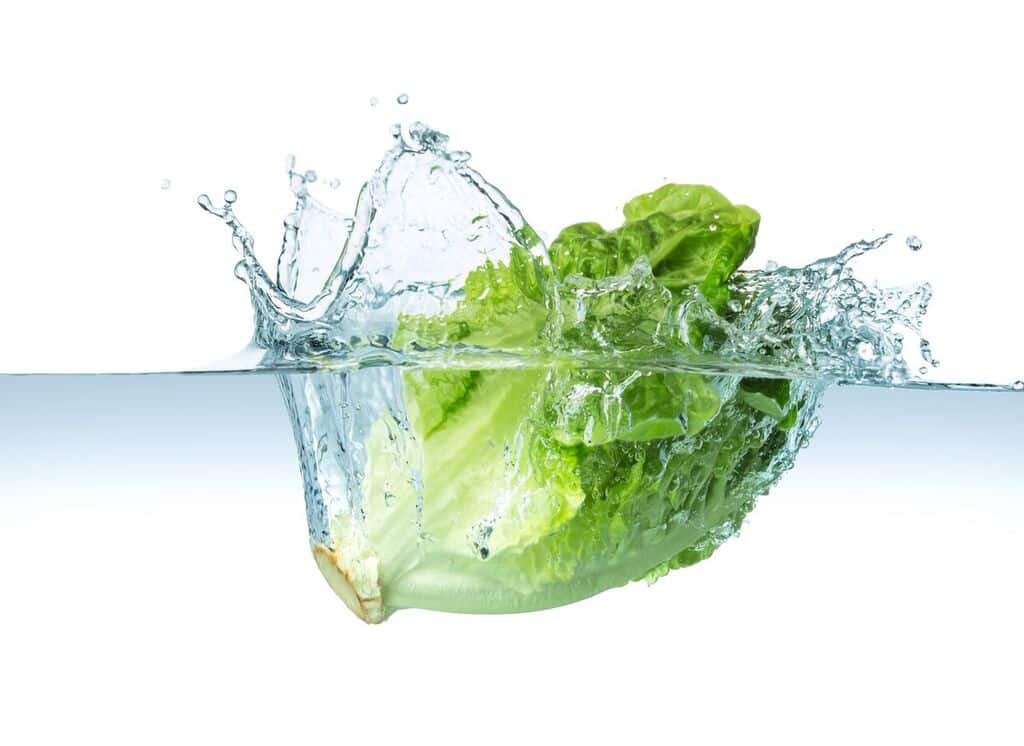
It’s extremely easy to incorporate iceberg lettuce into your diet. You can simply add it to your salads and sandwiches. If you want to get creative, ditch the hamburger buns and taco shell for iceberg leaves.
9) Spinach
Water Content: 92%
Just because you’re adding some iceberg lettuce into your diet that doesn’t mean you should ditch the darker greens altogether. Rather, you’re encouraged to blend them together to create a delicious salad with various flavors and nutrients. While iceberg lettuce has a higher water content, spinach contains a lot more nutrients. Just one cup provides more than 50 percent of your daily vitamin A needs, as well as being high in vitamin C and even protein.
10) Cabbage
Water Content: 92-93%
When it comes to cabbage you can buy either green or red (AKA purple). While they both have a high water content, green contains a tad more water than red. Green cabbage is 93 percent water, while red cabbage is 92 percent. Overall, they’re both great options for hydration. Plus, they’re rich in vitamins C, K, B, folate, manganese, magnesium, phosphorus, potassium, iron, calcium, and more.

Cabbage is a great addition to soups and salads. You can also stuff cabbage to create delicious dishes. If you’re looking to reap the hydrating benefits, though, be careful how you cook cabbage. Depending on how you cook it, you could strip some of the water.
11) Cantaloupe
Water Content: 90%
Eating just one cup (one serving) of this delicious melon can help you rehydrate and boost your immune system. Since cantaloupes are 90 percent water, they are extremely refreshing during the hot summer months. Plus, one cup delivers 100 percent of the daily recommended values of key vitamins A and C.
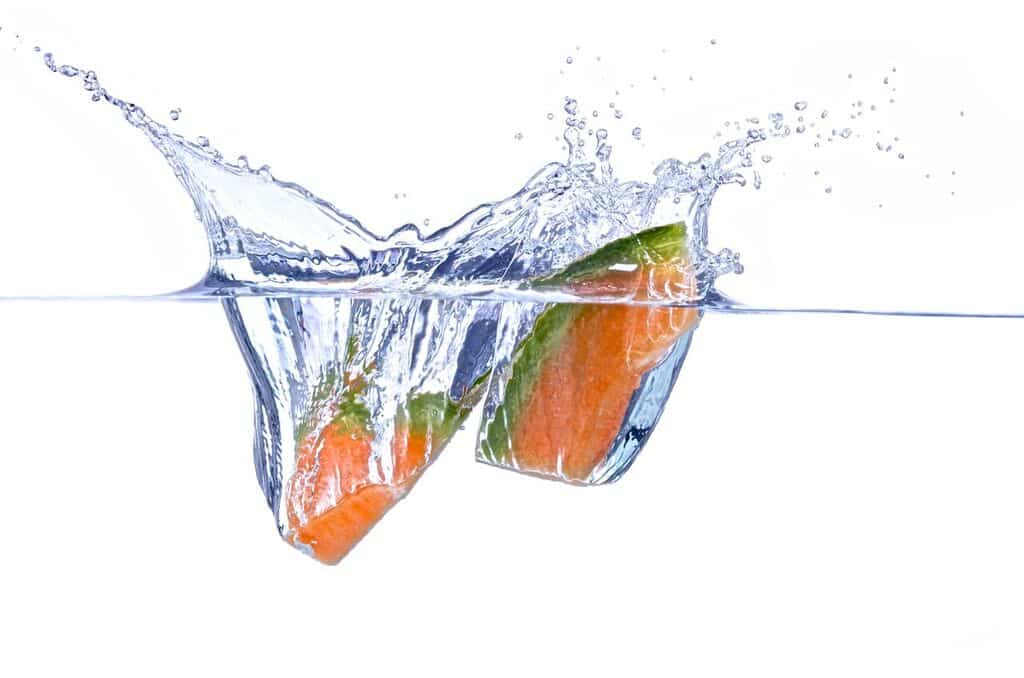
Cantaloupe is perfect for a refreshing snack or healthy dessert. All you have to do is slice it into quarters and eat! You can also dice it up and create a fruit salad (using some of the other fruits on this list too). If you’re in the mood to get creative, you can puree the cantaloupe to create ice pops, or blend it with some yogurt and pop it in the freezer to make sherbet.
12) Radishes
Water Content: 95%
Radishes tend to be one of those foods many people overlook when they’re food shopping. If you’re someone who doesn’t give radishes a second thought, it’s time for a change! These bright red bulbs have a distinct spicy-sweet flavor and are incredibly healthy. Along with being 95 percent water, they’re also rich in cancer-fighting antioxidants.
Adding radishes to your daily diet is simple. They’re a great flavor booster in salads, sandwiches, and tacos. You can also pickle them.
13) Peach
Water Content: 88%
You know you’re eating a good peach when the juice drips down your arm and makes your hands all sticky! Judging by how juicy this fruit is, you may have thought the water content would be higher than 88 percent (especially when you see that radishes are a whopping 95 percent water)! However, 88 percent is still enough water to help feed your body necessary H20!
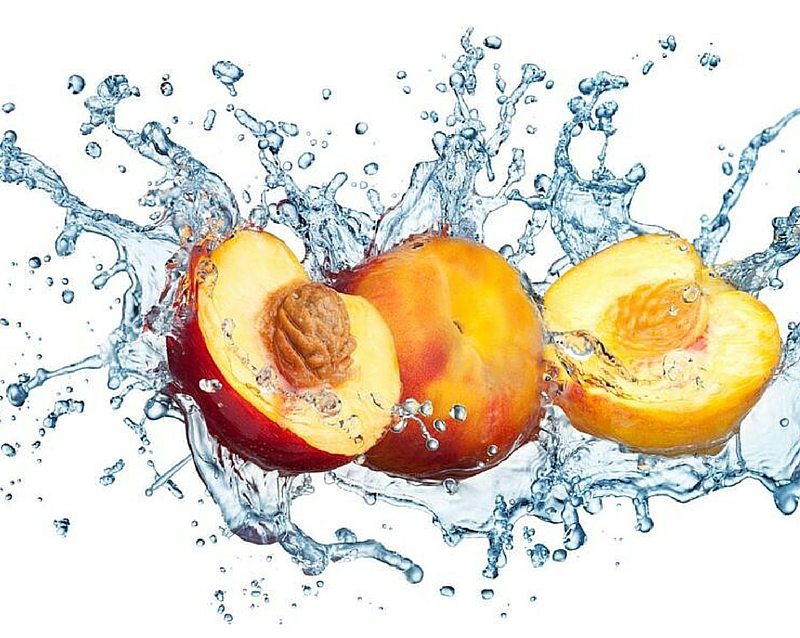
14) Apricot
Water Content: 86%
Thankfully, both peaches and apricots are in season during the hot summer months when we need them the most. Although, your window to get apricots is pretty small. They tend to bloom early, have little tolerance for the extreme heat, and are pretty difficult to ship. However, getting your hands on an apricot is like getting your hands on a tiny water bottle. They’re extremely hydrating! Plus, they’re rich in antioxidants, fiber, and beta-carotene.
15) Orange
Water Content: 87%
Everyone knows that oranges are rich in vitamin C and great for boosting the immune system. What a lot of people overlook, though, is the fact that oranges are extremely hydrating. Interestingly enough, they aren’t quite as hydrating as their look-alike grapefruit.
16) Grapefruit
Water Content: 91%
If you’re a fan of tangy grapefruit then you should definitely load up on them. Not only do grapefruits help keep your body hydrated, they can also help fuel fat burning and shrink your waistline. In one study, researchers found that eating half a grapefruit before each meal helped dieters lose about 3 1/2 pounds over a 12 week period.
17) Bell Peppers
Water Content: 92%
Have you ever noticed that when you crunch down on a bell pepper, a lot of refreshing liquid squirts out? That’s because they’re 92 percent water! When it comes to color (red, green, orange, or yellow), it doesn’t matter. All bell peppers are extremely hydrating. Plus, they’re nutrient dense. While red bell peppers may contain the highest levels of vitamin C, all colors are rich in beneficial antioxidants, vitamins, and minerals the body needs to function properly.
Note: Since sweet bell peppers are on the Dirty Dozen list, go organic whenever possible.

Bell peppers are great in salads, can act as an edible bowl, or simply slice and munch!
18) Cranberries
Water Content: 87%
There are potentially big benefits to eating fresh cranberries. They’ve been known to fight urinary tract infections, protect against certain types of cancer, boost the immune system, and help keep the body hydrated.
19) Cauliflower
Water Content: 92%
Although you may not realize it, cauliflower is mostly water. In fact, it has the same percentage of water as strawberries and a higher percentage of water than pineapples and peaches. Cauliflower’s high water content is what helps contribute to its crispiness.
While cauliflower is extremely versatile (there’s even cauliflower pizza crust), it’s best to eat it raw if you’re trying to benefit from the water content. As I’ve pointed out with several of the other vegetables on this list, the hydrating benefits are stripped once it’s grilled or sautéed.
20) Broccoli
Water Content: 91%
Since broccoli isn’t necessarily juicy, you may not have even realized it has such a high water content. This healthy veggie, however, is in fact 91 percent water, making it a great food to help hydrate your body. Along with providing your body with essential H2O, it also packs a strong nutritional punch. Did you know that one serving of broccoli has more vitamin C than an orange?
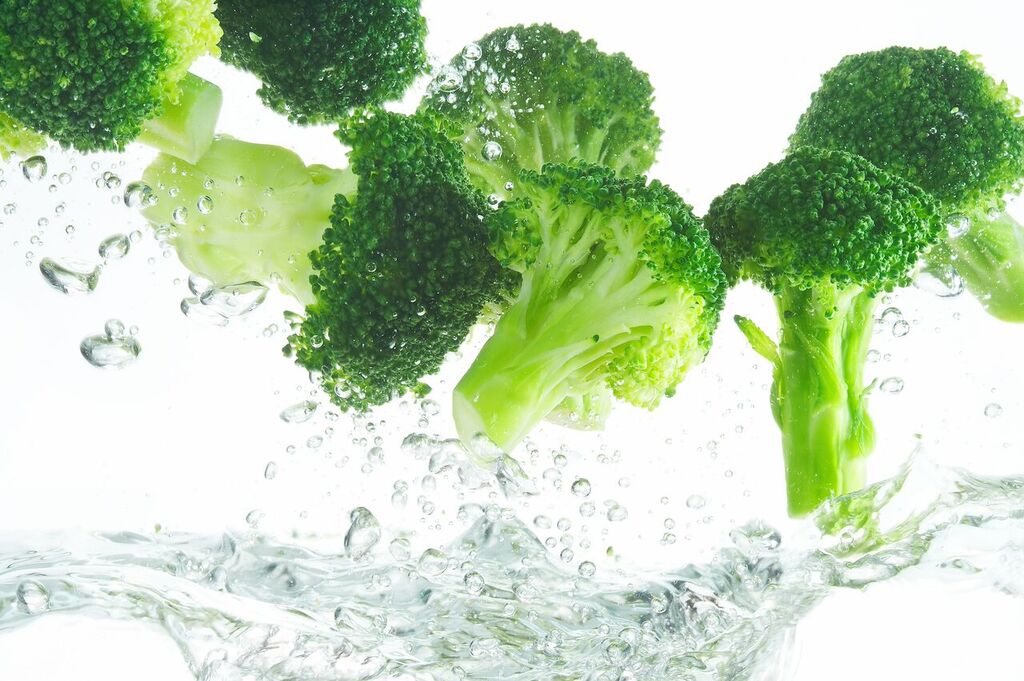
To keep the high water content, you’ll want to eat broccoli raw. It makes a great salad topper or dip some florets in salad dressing.
21) Raspberries
Water Content: 87%
Raspberries may not have as much water as strawberries do, but they’re still high up there in terms of water content! Plus, raspberries have more fiber (8 grams per cup) than any other commonly consumed berry.
22) Blueberries
Water Content: 85%
Is there anything blueberries can’t do? They’re known to fight cancer, boost the immune system, and support brain health. Plus, with 85 percent water, they also help the body hydrate.
23) Grapes
Water Content: 81%
Grapes are another healthy hydrating snack. Additionally, grapes are known to benefit heart health and boost the immune system. After all, one cup of grapes provides more than a quarter of the daily recommended values of vitamins K and C!
Note: Since grapes are on the Dirty Dozen list, you’re urged to buy organic grapes!
What Causes Dehydration
The body becomes dehydrated when it’s getting rid of more fluid than it’s absorbing. You probably don’t even realize it, but when you breathe, sweat, urinate and pass a bowel movement, your body is getting rid of fluid. It’s important to replenish that fluid. If you don’t then your body won’t be able to function properly. *See the signs of dehydration below.
Why Staying Hydrated Is So Important
Water is essential for life. Did you know our bodies are made mostly of water? In fact, the average adult human body is about 60 percent water. Babies are comprised of about 75 percent water. In order to keep our body’s systems working properly, we need to maintain a healthy balance between water and electrolytes. Staying hydrated helps to control our body’s temperature, heart rate, blood pressure, and metabolism. That’s not to mention, staying hydrated helps lubricate our joints and benefits our muscles.
Signs Of Dehydration
- Dark urine
- Less urination
- Extreme thirst
- Constipation
- Headache
- Lightheadedness
- Dry mouth
- Muscle cramps
- Rapid heart beat
- Low blood pressure
- No tears when crying
- Delirium
In severe cases, dehydration can lead to delirium or unconsciousness. It may even require hospitalization and emergency treatment.



